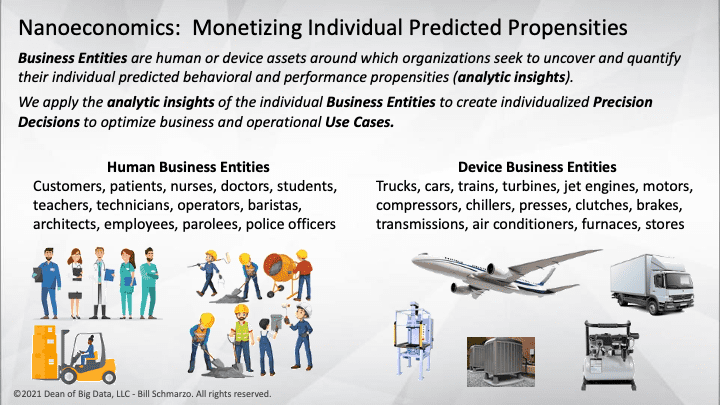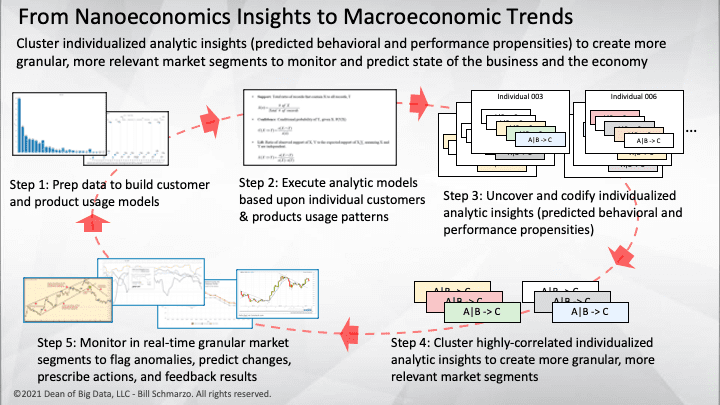
Do you remember those high school days when there was always this one cliché to which all the “kool” kids belonged? The “Kool Kids Klub” members held the best parties, got the best dates, got into the right colleges, got the right jobs, and married the right partners. And they accomplished all this cool stuff right in front of everyone, yet no one could figure out what made them so cool.
Well, your worst memories are back (if you weren’t a member of that Kool Kids Klub), because there is a “Kool Kids Klub” of Chief Data Officers (CDO) who are having more success, more influence on the organization, making more money, and being interviewed by top publications. And, like high school, these cool CDOs are doing it right in front of us! What the heck are we missing?
I hypothesize that part of the CDO “Kool Kids Klub” secret sauce is a mastery of economics. Yes, the research into my book “The Economics of Data, Analytics, and Digital Transformation” opened my eyes to how organizations could leverage the unique economic characteristics of data and analytics (assets that never deplete, never wear out, can be used across an unlimited number of use cases at zero marginal cost, can be engineered with AI / ML to appreciate they more that they are used) to create new sources of value. These new data and analytic economic concepts include (Figure 1):
- Nanoeconomics is the economics of individuals; the economic theory of individualized entity (human or device) predicted behavioral and performance propensities.
- Data Economic Multiplier Effect formulates the calculation of a data set’s accumulated attributable value from reusing that same data set across multiple use cases.
- Marginal Propensity to Reuse (MPR) states that an increase in the reuse of a data set across multiple use cases drives an increase in the attributable value of that data set at zero marginal cost.
- Economies of Learning measure an organization’s value creation effectiveness from continuously learning and adapting the organization’s data and analytic economic assets.
- Schmarzo Economic Digital Asset Valuation Theorem highlights the economic effects of the sharing, reusing, and continuously refining the organization’s data and analytic assets.
Figure 1: Key Data Economic Theorems and Principles
Over the past 40 years, there has been a seismic transformation in the value-creation capabilities of the world’s most valuable companies. The world’s valuable companies have transitioned from companies that were purveyors of products as the source of value creation to companies that are purveyors of knowledge as the source of value creation (Figure 2).

Figure 2: Transformation of the World’s Most Valuable Companies
Note: when folks insist that data monetization is about “selling one’s data”, look at the data innovation leaders in Figure 2 and ask yourself if you think Google, Amazon, or Apple are driving their data innovation by selling their data. It’s not data monetization; it’s insights monetization through the packaging (think data products) of the customer, product, service, and operational insights to create new sources of value.
One thing that companies such as Google, Amazon, and Apple seem to have in common is a Chief Economist. And not a Chief Economist responsible for modeling the world’s macroeconomic developments that they could get from government agencies. No, these organizations employ Chief Economists to refine the microeconomics of how the business is leveraging new economic assets (data and analytics) to create new sources of value.
But before we dive into how these organizations are exploiting the Chief Economist role, let’s first understand the similarities between a Chief Economist and a Chief Data Officer.
Chief Data Officers and Chief Economists Similarities
Chief Data Officer (CDO) is the senior executive responsible for driving cross-organizational alignment in the creation and management of data and analytics systems (including policies, processes, procedures, technologies, organizational education/literacy, skills, and capabilities) to accelerate the appropriate and ethical application of data and analytics to derive and drive new sources of quantifiable business and operational value.
- The CDO oversees and coordinates the capture, development, sharing, continuous refinement, and ethical application of the organization’s data and analytic assets to optimize the organization’s key business and operational use cases.
Chief Economist is primarily responsible for developing, coordinating, and producing an organization’s microeconomic capabilities. The Chief Economist is responsible for overseeing and influencing the organization’s development of the economic systems that enable the production and distribution of value.
- Chief Economists leverage Econometrics, the branch of economics concerned with using mathematical and statistical methods to define and describe economic systems. Econometrics uses economic theory, mathematics, and statistical inference to create economic models that can be helpful tools for defining and explaining how organizations and policies create value.
- An example of econometrics is to study the income effect on consumer spending using observable data. An economist may hypothesize that as a person increases their income, their spending will also increase. And an economist builds models to either accept or reject the hypothesis.
As the relationship between the Chief Data Officer and Chief Economist continues to mature (and morph?), one area of collaboration will be around the application of Nanoeconomics to exploit the organization’s growing bounty of data to create new sources of customer, product, service, and operational value (Figure 3).

Figure 3: Leveraging Nanoeconomics to Transition Decision-making from General Averages to Individualized Propensities
Nanoeconomics is economic theory of individual entity (human or device) predicted behavioral and performance propensities.
Nanoeconomics goes beyond microeconomics by applying economics at the individualized entity (human or device) level (Figure 4).

Figure 4: Nanoeconomics: Monetizing Individual Predicted Propensities
For example, in our previous example, we talked about how an economist may hypothesize that as a population increases its income, its spending will also increase. However, using nanoeconomics (economics at the individualized entity level), we can model and estimate the effect on each individual on how much an increase in income will increase their spending behaviors. We can then cluster those individual spending insights to create more granular, more relevant market segments to monitor and predict the state of the business and the overall economy (Figure 5).

Figure 5: From Nanoeconomics Individualized Insights to Macroeconomic Segments and Trends
The Digital Age Chief Economist
Google. Hal Varian is an example of a digital-age Chief Economist. Varian joined Google in 2002 as their Chief Economist and has developed econometric models for many of Google’s auction products (e.g., AdWords, AdSense, IPO, ad exchange, spectrum, and domain) and econometric models for revenue forecasting, advertiser behavior, and ad effectiveness. As Google’s chief economist, Hal Varian has revolutionized Google’s business strategy and business models.
Google’s application of microeconomics – the study of individuals, households, and firms’ behavior in decision-making and allocation of resources – is more complex yet more thorough, given its real-time feedback systems. For example, selling ads doesn’t generate only profits; it also generates torrents of data about users’ tastes and habits and reactions to their ad recommendations, data that Google uses to predict future consumer behavior, find ways to improve its products, sell more ads, and create new revenue streams.
The article “Secret of Googlenomics: Data-Fueled Recipe Brews Profitability” provides a peek inside the economics-driven nature of Google. For example, Google’s economics teams use data and analytics to continuously refine the econometric auction strategy that underpins Google’s search engine, the most profitable search engine in the industry. This constant self-analysis and data-fueled feedback is the heart of Googlenomics that defines not only Google’s future but the future of anyone who does business online.
Amazon. Pat Bajari is another example of a digital day Chief Economist. Bajari has been Amazon’s Chief Economist since August 2010. And not surprisingly, he is also the Vice President of Amazon Core AI. Bajari’s economics team applies econometrics, software development, and machine learning to make data-informed decisions.
To quote the job posting site on Amazon:
“Economists at Amazon are solving some of the tech sector’s most challenging applied economics questions. Amazon economists apply the frontier of economic thinking to market design, pricing, forecasting, program evaluation, online advertising, and other areas. Our economists build econometric models using our world-class data systems and apply economic theory to solve business problems in a fast-moving environment.”
Apple. I could not find anything definitive about Apple’s Chief Economist. So, I resorted to crawling Apple’s job site and found the job description for an Economist / Core Data Scientist.
- Strong background in statistics or econometrics: regression analysis, causal inference, time series analysis, GLM, logistic regression, probability theory, regularization, and interest in machine learning algorithms.
Data Scientists and economists use lots of the same tools to model and optimize the organization’s value creation processes. See Hal Varian’s white paper titled “Big Data: New Tricks for Econometrics” for more details on the use of data science concepts and AI / ML algorithms in econometrics.
Kool Kids Klub Summary
A potent combination of economics and data science is a key skill set for these leading digital age organizations that are exploiting data and analytics to create new sources of customer, product, service, and operational value.
I cannot say with 100% confidence that these digital leading companies are hiring Chief Economists to exploit the economics of data and analytics to transform their business models. I can’t say with 100% confidence that these Chief Economists are leveraging economic concepts to create new sources of value buried in their data. But there is certainly something going on at these digital leading organizations in blending data science and economic concepts to create new sources of value. And I can say with 100% confidence that that is what the leading Chief Data Officers are trying to do.
The key to success for both the Chief Data Officer and the Chief Economist is the ability to collaborate to build, manage and grow value creation systems that leverage data and advanced analytics (AI / ML) to not only optimize today’s business operations but also builds the necessary data and analytic assets to position the company’s business model for future success.
Yea, the Kool Kids Klub is back, and I will not miss getting invited this time!
